
The Church of Our Saviour, also known as the Church of Our Saviour at Mission Farm, the Mission of the Church of Our Saviour, and the Josiah Wood Jr. Farm, is a historic Episcopal church and farm complex located at 316 Mission Farm Road, in Killington, Vermont. The church is a Gothic Revival stone building, built in 1894-95 of Vermont granite. In addition to the church, the 170-acre (69 ha) Mission Farm property includes a c. 1817 farmhouse, a guest and retreat house, a vicarage, a bakery and agricultural buildings. On October 29, 1992, it was added to the National Register of Historic Places. Currently, The Rev. Lisa Ransom is the Executive Director of Mission Farm and Vicar of The Church of Our Saviour.
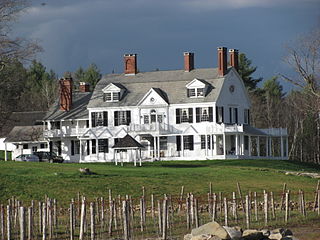
Brook Farm is a historic country estate farm at 4203 Twenty Mile Stream Road in Cavendish, Vermont. It includes one of the state's grandest Colonial Revival mansion houses, and surviving outbuildings of a model farm of the turn of the 20th century. It was listed on the National Register of Historic Places in 1993. The property is now home to the Brook Farm Vineyard.

Stonyfield Farm, also known as the Ebenezer Barrett Farm, is a historic farm on Barrett Hill Road in Wilton, New Hampshire. Established in 1803 by Ebenezer Barrett, the farm layout and buildings represent a well-preserved example of a rural hill country farm of the 19th century, which survived in part by being transformed into a gentleman's farm in the early 20th century. It is on this farm that noted yogurt maker Stonyfield Farm was founded. The farm was listed on the National Register of Historic Places in 1983.
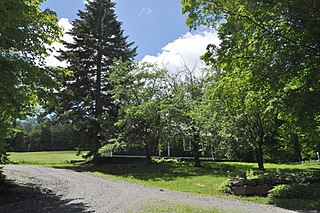
The Crows Nest is a historic farmstead property at 35 Sturgis Drive in Wilmington, Vermont. The 75-acre (30 ha) property includes rolling woods and a hay meadow, and a small cluster of farm outbuildings near the main house, a c. 1803 Cape style building. The property typifies early Vermont farmsteads, and is now protected by a preservation easement. It was listed on the National Register of Historic Places in 1998.

The Hager Farm is a historic farmstead on United States Route 7 in southern Wallingford, Vermont. Its farmhouse, built about 1800, is one of the oldest in the community, and is regionally unusual because of its gambrel roof. The property was listed on the National Register of Historic Places in 1986.

The Ezekiel Emerson Farm, also known as Apple Hill Farm, is a historic farm property at 936 Brandon Mountain Road in Rochester, Vermont. Occupying 38 acres (15 ha), the farm includes a mid-19th century bank barn and a c. 1920-1940 milk barn that are both well-preserved examples of period agricultural buildings. The house includes a fine example of a Late Victorian porch. The property was listed on the National Register of Historic Places in 2001.

Top Acres Farm, known historically as the Fletcher–Fullerton Farm, is a farm property at 1390 Fletcher Schoolhouse Road in Woodstock, Vermont. Developed as a farm in the early 19th century, it was in continuous agricultural use by just two families for nearly two centuries. It was listed on the National Register of Historic Places in 2004.
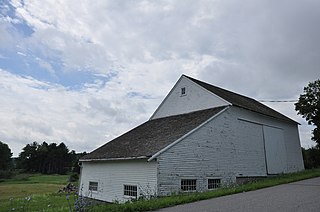
The Witherill Farm is a historic farm property on Witherill Road in Shoreham, Vermont. With a history dating to the late 18th century, the farm was for two centuries managed by generations of the same family, and was a noted early exporter of merino sheep to South Africa. Most of the farmstead buildings were built before 1850. The property was listed on the National Register of Historic Places in 1993.

The Wilcox-Cutts House is a historic house on Vermont Route 22A in Orwell, Vermont, USA. Its oldest portions date to 1789, but it is regarded as one of Vermont's finest examples of late Greek Revival architecture, the result of a major transformation in 1843. The house and accompanying farmland, also significant in the development of Morgan horse breeding in the state, was listed on the National Register of Historic Places in 1974.

The Aaron Jr. and Susan Parker Farm is a historic farm property at 1715 Brook Road in Cavendish, Vermont. Now just 16 acres (6.5 ha), the property includes a c. 1815 Federal style farmhouse, and a well-preserved early 19th century English barn. The farmstead was listed on the National Register of Historic Places in 2014.

The Isaac M. Raymond Farm, now Uphill Farm, is a historic farm property on North Bridgewater Road in Woodstock, Vermont, United States. The farm is the reduced core of a larger farm property accumulated in the first half of the 19th century by Isaac Raymond, and revived as a gentleman's farm in 1940. The property includes an altered 1805 Cape style farmhouse and 20th-century Colonial Revival farm buildings. It was listed on the National Register of Historic Places in 1993.

Field Farm is a historic farm property on Fuller Mountain Road in Ferrisburgh, Vermont. Developed around the turn of the 19th century, the property includes an early farmhouse and barn, as well as outbuildings representative of Vermont's trends in agriculture over two centuries. The property was listed on the National Register of Historic Places in 1995.
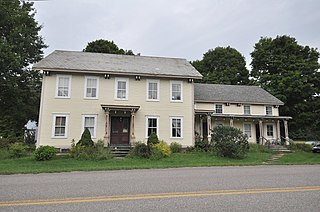
The Martin M. Bates Farmstead is a historic farm property on Huntington Road in Richmond, Vermont. Farmed since the 1790s, the property is now a well-preserved example of a mid-19th century dairy farm, with a fine Italianate farmhouse. The property was listed on the National Register of Historic Places in 1991.
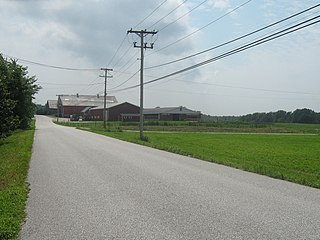
The Ballard Farm is a historic farm property on Ballard Road in Georgia, Vermont. At the time of its listing on the National Register of Historic Places in 1993, it had been under cultivation by members of the Ballard family for more than 200 years, having been established in 1788 by a sale from Ira Allen to Joseph Ballard.

Gray Rocks is a historic farm property on United States Route 2 in Richmond, Vermont. Developed in the early 19th century, it was in agricultural use until 1978, and has a well-preserved set of farm buildings dating from c. 1813 to the early 20th century. It was listed on the National Register of Historic Places in 1996.
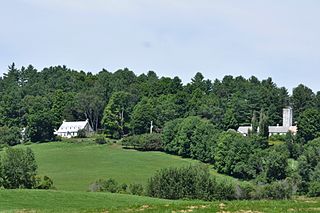
The William and Agnes Gilkerson Farm, also known more recently as the Kitchel Hill Farm, is a historic farmstead on Kitchel Hill Road in Barnet, Vermont. Established in the late 18th century by Scottish immigrants, it includes one of the finest known examples of a rubblestone farmhouse in the region. The property was listed on the National Register of Historic Places in 1992.

Lee Farm is a historic farm property on Vermont Route 18 in Waterford, Vermont. Established in 1801, it was for many years worked by members of the Lee family, and part of a thriving rural community called Waterford Hollow. Its farmstead features surviving 19th and early 20th-century outbuildings and a high-quality Greek Revival farmhouse. A 5-acre (2.0 ha) portion of the farm, encompassing the farmstead, was listed on the National Register of Historic Places in 1983.

The Josiah and Lydia Shedd Farmstead is a historic farm property at 1721 Bayley-Hazen Road in Peacham, Vermont. Established in 1816, the property evokes a typical 19th-century Vermont hill farm. Its oldest surviving buildings, the main house and two barns, survive from the second quarter of the 19th century. The property was listed on the National Register of Historic Places in 2005.

The West View Farm is a historic farm property on Hastings Road in Waterford, Vermont. The farm is unique for its distinctive round barn, built in 1903 to a design by St. Johnsbury architect Lambert Packard, and surviving 19th-century corn crib and smokehouse. The property was listed on the National Register of Historic Places in 1995. It includes a round barn.
The Luce Farm is a historic farm property at 170 Luce Drive in Stockbridge, Vermont. The farm was established in the late 18th century, and is a well-preserved example of a rural agriculturally diversified farm property. It was listed on the National Register of Historic Places in 2021.






















